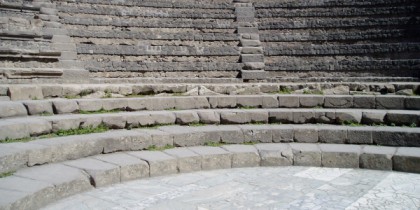
October 17, 2014, by Esther Eidinow
Tig, You’re It
Lynn Fotheringham, Director of the Centre for Ancient Drama and its Reception (based in the Classics Dept at Nottingham University), reviews Pilot Theatre’s current production of Antigone.
Pilot Theatre’s production of Sophocles’ Antigone (in a new version by Roy Williams) came to the Lakeside in the same week that we were covering screen-versions of Greek tragedy in our module, ‘Classics and Popular Culture’. About twenty people from the Department went to last Tuesday evening’s performance. It was a highly mediatised production which updated the story to a contemporary urban gang environment, with a stunning set. Wheeled dumpsters were moved on, off and around the stage to indicate shift of locale; one, when opened up and turned around, became a plush settee at a club owned by Creo (Sophocles’ Creon). A possible allusion to the original Greek setting were columns, two of concrete and two of iron mesh – at one point, the incarcerated Antigone appeared to be inside one of these].
The warring gangs of the setting provide an interesting parallel for the internecine conflicts of the tiny Greek city-states. I might compare The Gospel at Colonus,which assimilates the religious aspects of Greek tragedy to a gospel service. The opening scenes were faithful to Sophocles, with just some trimming and shifting of order: the scene between Esme (modernised Ismene) and ‘Tig’ (a culturally appropriate shortening) provided a particularly brilliant up-dating and psychologising of the potentially hard-to-relate-to characters of Sophocles’ prologue.
So far ‘version’ seemed the right description of this production, in the sense of ‘translation’: translation between cultures as well as translation into a particular dialect of ‘street’ English. It felt only slightly different from the last version of Antigone I saw in the theatre, at the National Theatre in 2012: a magnificent set with all the trappings of modern hi-tech warfare and communications conveyed the modern context of some small war-torn state, but the text was Sophocles (Don Taylor’s translation), with just some trimming of the choruses.
Then, after Tig is caught covering her brother’s body, there’s a scene between Creo’s wife and son which does not come from Sophocles, and I began to think that ‘adaptation’ would be a more accurate description, with Pasolini’s Medea providing a closer parallel among films of Greek tragedy. The additions continue, alternating with scenes which are very close to the original. One of their purposes would seem to be to deepen the love-story between Tig and Eamon (a clever modern tweaking of ‘Haemon’), and to give an actual character to Creo’s wife Eunice (Eurydice), who in the Sophocles only comes on at the end for a few seconds in order to hear the bad news and then go off-stage and kill herself.Perhaps this expansion came from a very laudable desire to give a female character something more to do.
As a Classicist interested in cultural translation, I’d love to see a ‘version’ of the Antigone transposed to the same urban cultural context, one that didn’t add anything, just to see how it worked. Williams’ Antigone, instead, stands in the long line of adaptations which build on the Antigone to create something new. This is an equally fascinating process to watch, and I highly recommend the production, which continues touring until next March.
(The screen versions of tragedy mentioned here, and many more, are available for Classics students and staff to borrow from the Departmental library.)
Image: Odeon, Pompeii, by Lynn Fotheringham.
No comments yet, fill out a comment to be the first

Leave a Reply